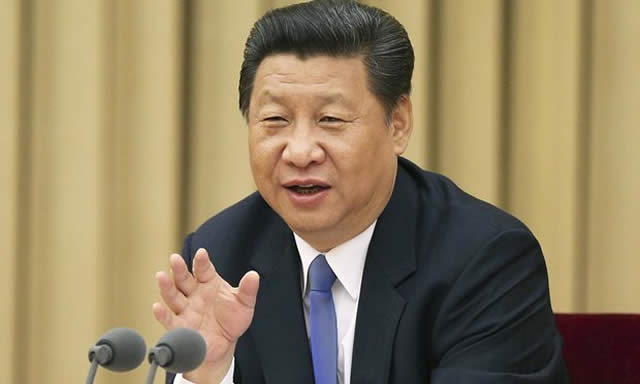Unpacking China’s $4bn Zim investment


China’s President Xi Jinping
Dr Fay Chung Correspondent
Zimbabwe also needs enormous inputs into human capacity building. The enlargement and improvement of education and training after Independence have been impressive. However, there is need to link education and training to greater science, technology and industrialisation.
China’S President Xi Jinping surprised both Chinese and Zimbabweans when he upped the promised donor funds-cum-Foreign Direct Investment or FDI to US$4 billion. This potential combination of grants and loans for Zimbabwe is over the three-year period, 2016-2018. It is part of the US$60 billion promised to 54 African countries at the FOCAC meeting between African and Chinese Heads of States held in Johannesburg a week later.
Previous Chinese aid and FDI to Zimbabwe is estimated at about US$600 million in 2015, compared to about US$22 billion for South Africa and US$2 billion for Zambia.
China’s huge increase in investment into Africa must be seen within the global perspective: the two huge markets which helped China to explode into the second biggest economy in the world was partially fuelled by the importation of modern industrial technologies from the West, mainly the USA and Germany, two of the foremost countries in modern industrialisation.
The USA and the European markets were also opened to massive Chinese exports, whilst American and European industries rushed to manufacture in China because of its superior work force and low production costs. However, since the 2007 financial crises in the two continents, they have become unable and unwilling to further expand their markets to Chinese produced goods.
The shrinking of exports to the West has forced China to re-orient its very large industrial capacities: China has developed two strategies – firstly to increase the domestic market; and secondly to expand their industrial capacities into Africa, Asia and South America, all of which are under-industrialised.
Thus China’s offer to Africa can be seen as part of their “win-win” strategy, where both partners would benefit. China’s industries can expand into these under-industrialised countries; whilst the under-industrialised countries will benefit from access to modern industrialisation techniques, technologies, management systems, and regional markets. Such a strategy would benefit China, and would also benefit under-industrialised economies.
Joint industrialisation partnerships between the two sides would be natural, whether this is between governments, parastatals, capacity building institutions, or private companies.
Zimbabwe’s Advantages and Challenges
Zimbabwe, like all African countries, suffers from weak and poor industrialisation, having been utilised for more than a century by colonialists as the source of raw materials and a market for cheap goods produced in the colonial heartlands. Since Independence, all African countries have attempted to introduce various forms of industrialisation, but have been hampered by limited infrastructure, particularly electricity and transport; lack of finance; lack of markets; and lack of industrial technologies and experience. The Chinese initiative offers a sudden and huge input into industrialisation.
Zimbabwe has many advantages compared to many of its neighbours, including:
- It’s a medium-sized country of about 13 million people, so it has a sufficient domestic market for most industries: industries benefit from having a discerning local market which prepares its industries for improving the quality of their products. Such qualitative and affordable products can then readily be exported to similar markets.
- It has had more than half a century of industrialisation, albeit such industrialisation was based on 1950s technologies, management systems and narrow domestic markets. Nevertheless this experience means that Zimbabwe already possesses considerable infrastructure including factories; an industrialised workforce; and an educated and well-trained workforce accustomed to industrial work.
- Zimbabwe is a peaceful country, with limited labour unrest. Its strong security forces have succeeded in protecting the country from challenges which could have made Zimbabwe disorderly, ungovernable and even chaotic.
- Zimbabwe has a popularly elected government, and has had regular elections every five years. Whilst these have also been regularly contested, this important institution has stood the test of time. Elections remain an important aspect of freedom and democracy, although the “winner takes all” system takes little consideration of other essential economic, professional and governance institutions. Elections remain an essential, but not sufficient foundation for economic growth.
- Zimbabwe has a number of good tertiary technical and vocational training centres, such as polytechnics and technical universities, although their technologies require some updating. Both secondary and tertiary education and training centres have a sound foundation, and increased capacity building can be based in many such institutions.
- Zimbabwe has good trade relations with other countries in the region, offering a vast potential market for manufactures which are in demand.
Zimbabwe also has a number of challenges:
- Zimbabwe’s electricity system is limited and unreliable, although there are already some funded projects in place based on hydro and solar energy.
- Utility costs are very high compared to those in the region.
- Industrial wage levels are based on the wages formerly paid to white settlers, and are uncompetitively high compared to those in Asia. Minimum wages are at least three or four times more than Zimbabwe’s per capita income, impeding industrial expansion. These relatively high wages are comparable to those in neighbouring countries which have had a similar settler-colonial history. The present pay levels, separately negotiated with the different trade unions, prevent an increase in the employment level. Labour laws need to be more flexible to encourage companies to expand employment.
- There is a tragic division between the formal and informal economies, with the State concentrating mainly on the formal economy, which only caters for 4 percent of the population. The informal economy, which catered and still caters for 96 percent of the population, is neglected and even persecuted. To go forward the divisions between the formal and informal economies, inherited intact from settler-colonialism, must be bridged, and must receive equal Government attention and investment.
- The State and the private sector, both in the formal and informal economy, do not work closely together: there is a measure of distrust inherited from the historic origins of the different groupings and institutions. Government remains secretive, so that many of the decisions made lack sufficient consultation and participation with important private economic institutions, yet it is the private sector which can take the economy forward. But this cannot happen without staunch and long-term support from a strong State.
- The Zanu-PF Government was founded through the liberation struggle. Its robust political structures and institutions were formed during the liberation struggle. This is its strength. It also presents serious challenges as many changes have taken place since Independence in 1980. Zanu-PF naturally looks back on its history of the liberation struggle with pride; it will also need to bring about a blueprint for the economic liberation struggle. Zim-Asset, like its many predecessors over the past three decades, is oriented towards political support, and cannot serve as a practical strategic plan.
- There is a high level of corruption both in the public and the private sector, based on the use of political patronage to obtain bank loans and State contracts. Linking industrial and investment opportunities closely to political criteria has proved to be an inefficient and unnecessarily expensive strategy, as those who benefit from political largesse may not have the technical competence to run sophisticated enterprises. This close linkage between patronage and business undermines the efficiency of the economy.
- Whilst the principle of citizens having major control of the means of production is universally accepted, the present Indigenisation Act and Regulations are seriously problematic, and have been interpreted in very different ways by different stakeholders. Moreover, the wording is threatening and potentially violent, threatening would-be investors with draconian punishments such as heavy fines and imprisonment. The poorly drafted legislation has already proved to be unacceptable to nearly all investors.
What Are China’s Priorities?
China has made it clear that it prioritises the following:
a. Improving infrastructure in Africa including railways, roads, aviation, ports and electricity. It will include 100 clean energy projects and the building of five transport universities;
b. Agricultural modernisation, including emphasis on technology transfer and small-scale farming;
c. Emphasis on small and medium- sized Enterprises (SMEs) under the China-Africa Development Fund and Special Loan for the Development of African SMEs which received an increase of US$5 billion;
d The establishment of a China-Africa Fund for Production Capacity Co-operation with an initial contribution of US$10 billion;
e. The industrialisation of Africa, including the beneficiation of its raw materials;
f. Human Resource Development of Education and Health, including 30 000 scholarships and the training of 20 000 technical staff;
g. 200 “Happy Life” projects for women and children for the least developed countries under a poverty reduction plan.
Will Zimbabwe divide its project proposals realistically under these different categories? How far will the formal and informal sectors be involved in the planning and implementation for these funds?
Potential Impact of the Chinese Aid and FDI
Like every intervention, there are potential positive and negative impacts. It is important for all Zimbabweans to examine and agree on how this US$4 billion can be utilised to bring about economic growth and work creation over the next three years. It would be appalling if this huge investment opportunity were wasted, without bringing about any substantive improvement in the economy and in the welfare of the majority of the population. It is also unlikely that Zimbabwe will get another such windfall over the next five to 10 years.
It is essential to prioritise what Zimbabwe will need to achieve this economic breakthrough. At present the only policy document is Zim-Asset, which covers all areas, but without specific prioritisation. Zim-Asset requires an estimated US$28 billion, which is not available. Whilst everyone can agree with Zim-Asset objectives, it does not provide a strategic game plan that can transform the economy: Zimbabwe’s economy is essentially an underdeveloped primary product economy.
Clearly the economy has to be transformed into an advanced modern economy with strong manufacturing industries. There should also be a time line which will identify what are the essential foundations, and what can be built on these foundations. The FOCAC time line is three years. Zimbabwe needs to identify its priorities in such a way as to lay sound foundations and create the building blocks for the future.
It is not difficult to identify the four key areas needed to provide the foundation and building blocks. These include:
- Infrastructure: however, there is a danger in concentrating only on infrastructure, particularly as engineers and investors always see infrastructure as highly profitable investments which may or may not bring about economic growth. A pertinent example is the tearing up of inherited railway lines to be replaced by new railways lines which cannot link up to neighbouring countries, as has happened in West Africa.
- The modernisation, diversification and improvement of agriculture which is the foundation of all development: Zimbabwe has a large traditional agriculture under the communal and resettlement areas which can benefit from improved inputs and training. Agricultural output could literally double within a short period of time, as happened in the 1980s.
- The modernisation and re-equipment of key industries such as machinery, fertiliser, seeds and equipment for agriculture. Two other areas which already have ready domestic markets are the pharmaceutical and the construction industries.
- The building of bridges linking the formal to the informal economy such that the best informal industries, which include most of the SMEs, can be modernised and empowered. Linking the two economies will bring about synergies and economies of scale, improving both internal and export markets. The difficult question of how to lower unit costs, which is based largely on wage costs, will depend greatly on how the two economies are joined together. Informal industries are presently characterised by very low wages: these wages can and should be increased, and this is only possible through greater modernisation and enlarged markets. There should be investment into both the formal and informal economies.
In addition to these four key areas, Zimbabwe also needs enormous inputs into human capacity building. The enlargement and improvement of education and training after Independence have been impressive. However, there is need to link education and training to greater science, technology and industrialisation. Zimbabwe’s industries need modernisation, professionalisation, the joining together of the formal and informal industrial sectors, and the production of machinery and consumer goods for domestic as well as regional markets. Partnership with high quality Chinese institutions, including research and development institutions, State- owned enterprises and private enterprises, will be invaluable for Zimbabwe’s future development, both in terms of technology transfer and management improvement, and in terms of new financial inputs.
Conclusion
Zimbabwe stands at the cusp of a new economic era: it can go forward into modern industrialisation, or it can remain within its stunted inherited economy. The inherited economy is divided into the formal economy which serves about 4 percent of the population; and the informal economy which serves 96 percent of the population. Only an advanced breakthrough into modern industrialisation can unite this divided heritage. The US$4 billion offered to Zimbabwe is part of the US$60 billion for Africa as a whole. If Zimbabwe fails to modernise, it will have indeed wasted invaluable opportunities. No doubt its neighbours, South Africa and Zambia, will be able to utilise these opportunities effectively.









Comments